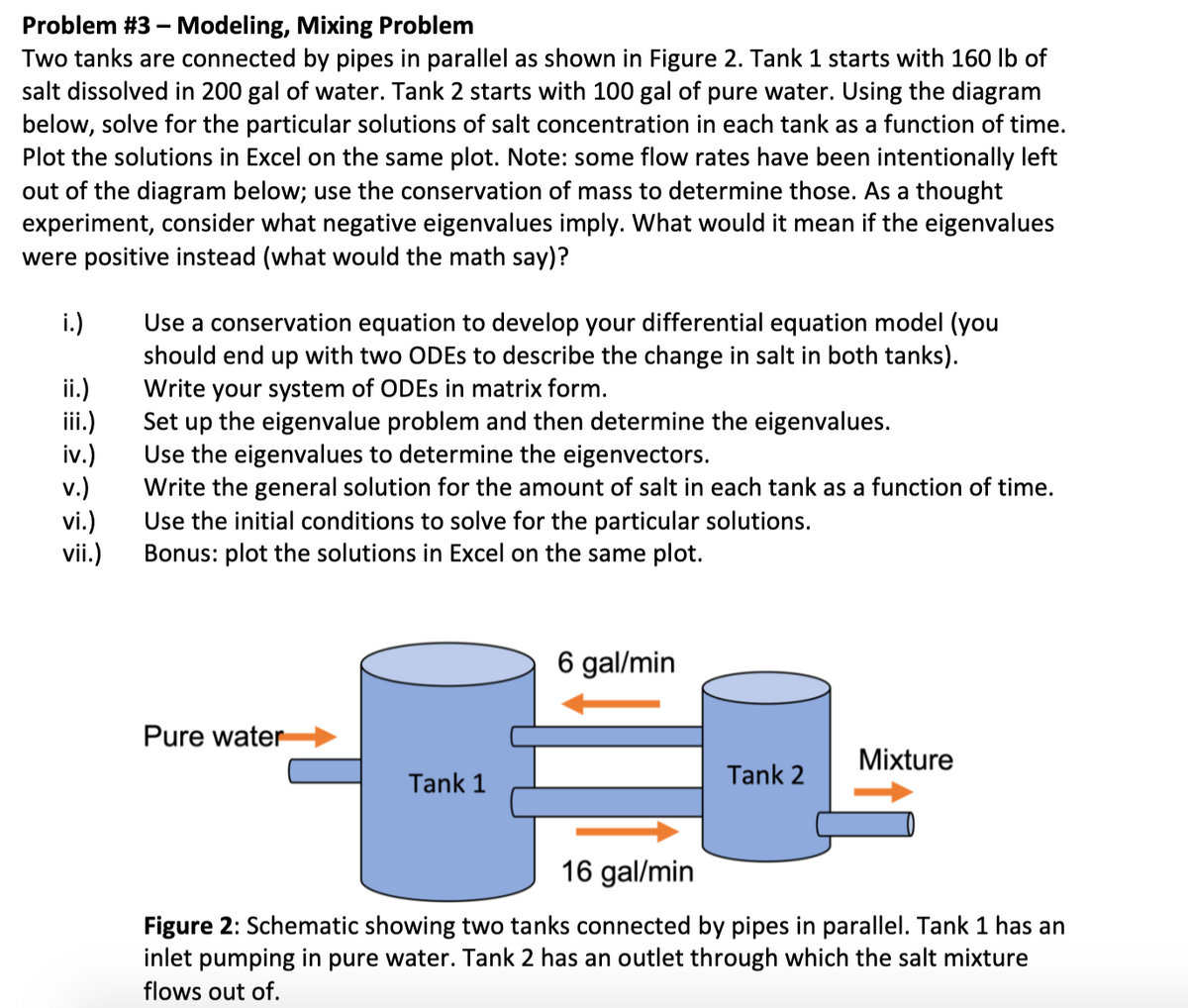Excel on the same plot. Note: some flow r below; use the conservation of mass to det er what negative eigenvalues imply. What d (what would the math say)? servation equation to develop your differ
Excel on the same plot. Note: some flow r below; use the conservation of mass to det er what negative eigenvalues imply. What d (what would the math say)? servation equation to develop your differ
Elements Of Electromagnetics
7th Edition
ISBN:9780190698614
Author:Sadiku, Matthew N. O.
Publisher:Sadiku, Matthew N. O.
ChapterMA: Math Assessment
Section: Chapter Questions
Problem 1.1MA
Related questions
Question

Transcribed Image Text:Problem #3 - Modeling, Mixing Problem
Two tanks are connected by pipes in parallel as shown in Figure 2. Tank 1 starts with 160 lb of
salt dissolved in 200 gal of water. Tank 2 starts with 100 gal of pure water. Using the diagram
below, solve for the particular solutions of salt concentration in each tank as a function of time.
Plot the solutions in Excel on the same plot. Note: some flow rates have been intentionally left
out of the diagram below; use the conservation of mass to determine those. As a thought
experiment, consider what negative eigenvalues imply. What would it mean if the eigenvalues
were positive instead (what would the math say)?
i.)
ii.)
iii.)
iv.)
v.)
vi.)
vii.)
Use a conservation equation to develop your differential equation model (you
should end up with two ODEs to describe the change in salt in both tanks).
Write your system of ODEs in matrix form.
Set up the eigenvalue problem and then determine the eigenvalues.
Use the eigenvalues to determine the eigenvectors.
Write the general solution for the amount of salt in each tank as a function of time.
Use the initial conditions to solve for the particular solutions.
Bonus: plot the solutions in Excel on the same plot.
Pure water
Tank 1
6 gal/min
Tank 2
Mixture
16 gal/min
Figure 2: Schematic showing two tanks connected by pipes in parallel. Tank 1 has an
inlet pumping in pure water. Tank 2 has an outlet through which the salt mixture
flows out of.
Expert Solution
This question has been solved!
Explore an expertly crafted, step-by-step solution for a thorough understanding of key concepts.
Step by step
Solved in 3 steps with 1 images

Knowledge Booster
Learn more about
Need a deep-dive on the concept behind this application? Look no further. Learn more about this topic, mechanical-engineering and related others by exploring similar questions and additional content below.Recommended textbooks for you

Elements Of Electromagnetics
Mechanical Engineering
ISBN:
9780190698614
Author:
Sadiku, Matthew N. O.
Publisher:
Oxford University Press

Mechanics of Materials (10th Edition)
Mechanical Engineering
ISBN:
9780134319650
Author:
Russell C. Hibbeler
Publisher:
PEARSON

Thermodynamics: An Engineering Approach
Mechanical Engineering
ISBN:
9781259822674
Author:
Yunus A. Cengel Dr., Michael A. Boles
Publisher:
McGraw-Hill Education

Elements Of Electromagnetics
Mechanical Engineering
ISBN:
9780190698614
Author:
Sadiku, Matthew N. O.
Publisher:
Oxford University Press

Mechanics of Materials (10th Edition)
Mechanical Engineering
ISBN:
9780134319650
Author:
Russell C. Hibbeler
Publisher:
PEARSON

Thermodynamics: An Engineering Approach
Mechanical Engineering
ISBN:
9781259822674
Author:
Yunus A. Cengel Dr., Michael A. Boles
Publisher:
McGraw-Hill Education

Control Systems Engineering
Mechanical Engineering
ISBN:
9781118170519
Author:
Norman S. Nise
Publisher:
WILEY

Mechanics of Materials (MindTap Course List)
Mechanical Engineering
ISBN:
9781337093347
Author:
Barry J. Goodno, James M. Gere
Publisher:
Cengage Learning

Engineering Mechanics: Statics
Mechanical Engineering
ISBN:
9781118807330
Author:
James L. Meriam, L. G. Kraige, J. N. Bolton
Publisher:
WILEY